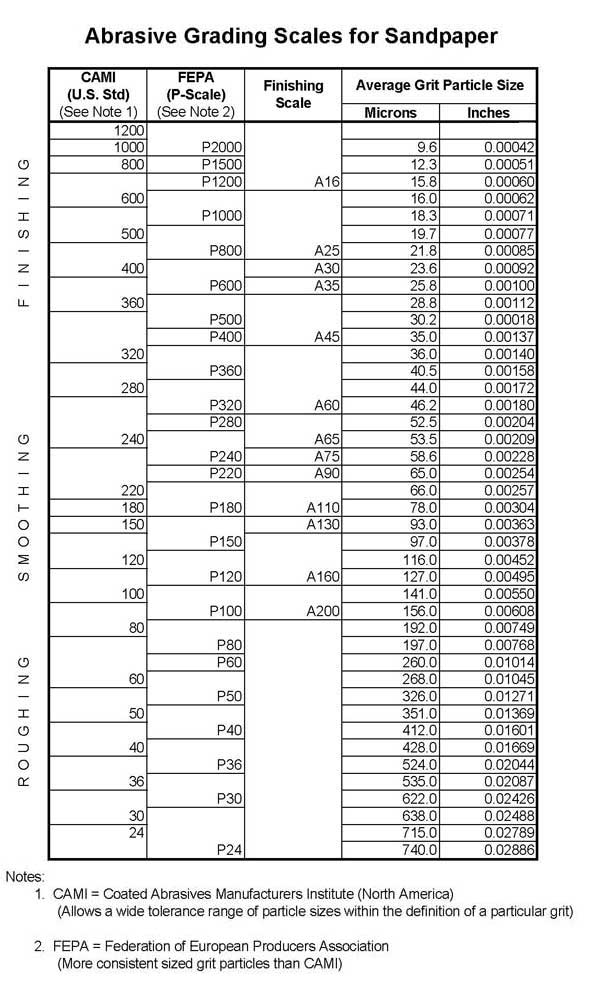| WWW.SEABEAN.COM HOME PAGE | Main page on: Polishing by Sanding | E-MAIL Contact Info |
A Few Words about Sandpaper
|
In that article provided by Bill Blazek, he suggests the use of grit numbers 120, 180, 220, 400, 600 and 1500. The coarseness of sandpaper is referenced by "grit numbers" with the coarser grit being smaller numbers. Most sandpaper is sold at your local hardware store, in pagkages of a few sheets, and labelled as 400 grit, 600 grit, etc. This works ok, financially, if you're going to hand sand just a few beans. If you're going to get serious, you'll want to purchase sandpaper in bulk... not typically available at your local hardware store. Searching the internet for bulk sandpaper, you may find that some grit numbers are prefixed with a "P" ...for example: P1000 and P1500, etc. Be careful! Sandpaper is graded by four scales, a North American scale (CAMI, Coated Abrasives Manufacturers Institute), a European scale (FEPA, Federation of Eruopean Producers Association), the Finishing Scale, and the Micron Scale. The European scale will be prefixed by a "P" before the grit number. Each scale is similar to the other, in the coarse ranges (smaller numbers, up to about 220), but begin to differ dramatically with the finer grits (higher numbers)... this can be misleading if you don't compare the grit scales. Other abrasive scales also exist, such as MMR & MMX (see chart, below). CAMI vs FEPA: These scales differ not only in their reference to grit sizes, but the two grading systems differ in that the European scale (the P-scale) differs in that it has more stringent guidelines regarding how variable the particle sizes can be on the paper. For example, if 220 grit is supposed to be made up of particles that are 60 microns in size, those particles on paper graded by the P-scale will all be closer to 60 microns than on the paper graded by the CAMI scale. In a nutshell: the particles on the P-scale paper are more uniform in size and closer to the size they are supposed to be... simply put, P-scale paper is better sandpaper (abrasively speaking) and provides for more consistent sanding results. Although sounding a bit paradoxical: Sandpaper smooths surfaces by scratching them... the more uniform the scratches, the smoother the sanded surface becomes. More uniform still (the very best!) are the "micron-graded" abrasives. The sandpaper also comes in a couple of mediums, each designed for use with its own target items to be sanded. The four abrasive materials are, from softest to hardest: aluminum oxide, silicon carbide, cermaics, and garnet. In addition to paying high prices for a few sheets of sandpaper at your local hardware store, sandpaper can be purchased in bulk (50 sheets/box) from online vendors such as Online Industrial Supply. These folks offer Silicon Carbide sandpaper up to P2500 grit (8.4 microns). Another material, called Micro-Mesh (MMR, Micro Mesh Regular; vs MMX) is a cushioned abrasive which has very fine particles embedded in a flexible cotton backing... anyone using this for sea-beans? See also: Rockler (and Rockler coupons!). |
From several sources, I have compiled a composite scale of grits in PDF format and HTML format.
MMR |
MMX |
ANSI or CAMI USA |
- |
80 |
280 |
- |
100 |
320 |
- |
120 |
340 |
- |
150 |
360 |
1500 |
180 |
400 |
1800 |
240 |
600 |
2400 |
320 |
800 |
3200 |
360 |
1200 |
3600 |
400 |
1350 |
4000 |
600 |
1500 |
6000 |
800 |
2000 |
8000 |
1200 |
2500 |
12000 |
- |
Submicron finish |
Not on the chart below, or differing from the chart,
1500 CAMI grit = 3 microns; 2000 CAMI grit = 1 micron; 12000 CAMI grit = .5 microns!!!
2000 FEPA grit = 10.3 microns; 2500 FEPA grit = 8.4 microns

Scale above is available on The Glendale Woodturners Guild website
Other scales, which differ somewhat, mostly in the finer ranges:
www.sizes.com